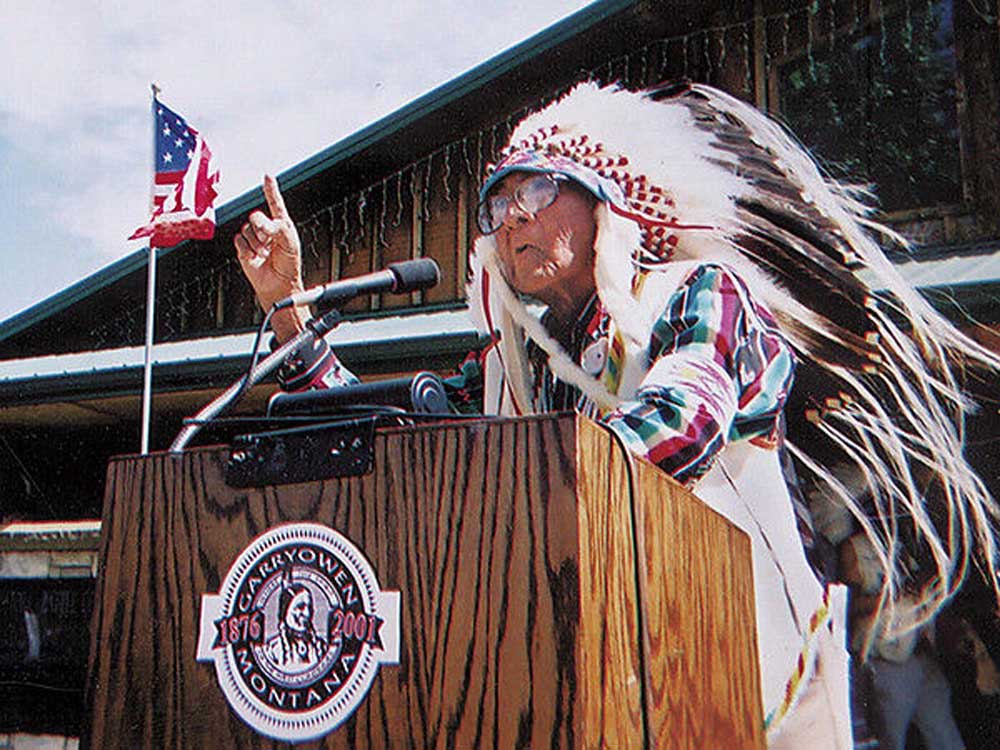Joe Medicine Crow, Native American who was Crow Nation’s last war chief, dies at 102
Published 6:24 pm Monday, April 4, 2016

- In this 2001 photo, Crow tribal historian Joseph Medicine Crow speaks of unity at a dedication of a "Peace Memorial," near where the bloody Battle of the Little Bighorn began 125 years ago, in Garryowen, Mont. Acclaimed Native American historian Medicine Crow died Sunday, April 3, 2016, in a hospice at 102 years old. He grew up hearing stories from direct participants in the Battle of Little Bighorn. He later became his tribe's last surviving war chief. (AP Photo/Beck Bohrer, File)
Joe Medicine Crow, an American Indian who wore war paint under an Army uniform during World War II, conducting battlefield heroics that made him his tribe’s last war chief, and who distinguished himself as a guardian of his people’s history, died April 3 at a hospice center in Billings, Montana. He was 102.
A half-sister, Louella Whiteman Runs Him Johnson, confirmed his death and said she did not know the cause.
In 2009, President Barack Obama presented Medicine Crow with the Presidential Medal of Freedom, the nation’s highest civilian honor. The award recognized him as “a warrior and living legend” whose military service, educational achievement and dedication to cultural preservation made him a “symbol of strength and survival.”
Medicine Crow once remarked that he had divided his life between “two worlds.” One was that of the Crow Nation, the small Northern Plains tribe to which he belonged, located primarily in Montana. The other was the world beyond the reservation, where he was known as an ambassador for American Indians.
He became the first member of his tribe to graduate from college and receive a master’s degree, then joined the armed forces and was sent to wartime Europe. An ocean away from his tribal territory, he encountered the opportunity to complete the traditional war deeds, or coups, required for the designation of war chief.
Among those deeds was the capture of an enemy – in his case, German – horse. Medicine Crow was credited with taking 50.
After the war, he became the official historian of the Crow. For more than six decades, he endeavored to preserve the memory of his ancestors, among them his grandfather Whiteman Runs Him, a scout for George Armstrong Custer during the American Indian Wars.
“There is absolutely no one like him left in America, in Indian country,” Herman J. Viola, a curator emeritus of the National Museum of the American Indian, said in an interview.
Joseph Medicine Crow was born in Lodge Grass, Mont., on Oct. 27, 1913, and grew up on a reservation.
“In those days Crow families didn’t have furniture,” he later recalled. “There were no beds. Everyone slept on the floor on blankets.” Softballs, he recounted, were fashioned “out of buckskin and stuffed with fur from a deer’s tail.”
Medicine Crow grew up with grandparents who had lived before the establishment of reservations. They schooled him in ancient customs, teaching him to run barefoot in the snow and wash himself in frigid river water.
He also absorbed the Crow traditions of loyalty and valor in battle. The Crow had been known for their patriotism since the 19th century, according to Viola, when they sought to defend themselves from encroaching tribes by allying themselves with Custer, a U.S. cavalry commander.
The National Park Service described Medicine Crow, who was 11 when his grandfather Whiteman Runs Him died, as “the last living person with a direct oral history from a participant of the Battle of Little Bighorn in 1876,” where Custer was killed and his forces overwhelmingly defeated.
Years later, Medicine Crow would observe that the Indians had “won the battle and lost a way of life.”
As a tribal leader, Medicine Crow advocated on behalf of American Indians for educational opportunities greater than those initially offered to him. He attended schools with mixed student populations and recalled a white girl tormenting him by jabbing him with a safety pin. The Indian children, he said, belittled each other for “trying to be a white man” by speaking English.
At age 10, he could not read. But he persevered in his effort to gain an education. He would later say, according to Viola, that “with an education, you are a white man’s equal; without an education, you are his prisoner.”
Medicine Crow received a bachelor’s degree in sociology and psychology from Linfield College in McMinnville, Oregon, in 1938 and a master’s degree in anthropology from the University of Southern California in 1939.
He was working toward a doctorate when he decided to enlist in the Army. In combat, he carried a feather for protection. His decorations included the Bronze Star Medal.
After the war, he became a land appraiser with the Bureau of Indian Affairs, donning a jacket and tie during the day. But “after 5 o’clock,” he remarked to an interviewer, “I’d turn into an Indian.”
For his historical and anthropological research, Medicine Crow conducted extensive oral histories with tribal elders. He became a sought-after speaker and published writings including the books “From the Heart of the Crow Country: The Crow Indians’ Own Stories” (1992) and “Counting Coup: Becoming a Crow Chief on the Reservation and Beyond” (2006).
His first wife, the former Charlotte Heminger, died in 1942. His second wife, the former Gloria Morrison, died in 2009 after 61 years of marriage.
Survivors include a son from an earlier relationship, Duane Brink of Salem, Oregon; a daughter from his first marriage, Diane Medicine Crow Reynolds of Three Forks, Montana; a son from his second marriage, Ronald Medicine Crow of Lodge Grass; his half-sister; and numerous grandchildren and great-grandchildren. A daughter from his second marriage, Vernelle Medicine Crow, died in 2015.
In an interview with Linfield College, Medicine Crow once reflected on his distinction as the last Crow war chief. He observed that he would join “the ranks of Sitting Bull, Geronimo, Black Hawk and all the brave warriors of the past protecting their lands and their way of life.”
Author Information:
Emily Langer is a reporter on The Washington Post’s obituaries desk. She has written about national and world leaders, celebrated figures in science and the arts, and heroes from all walks of life.
(c) 2016, The Washington Post · Emily Langer · NATIONAL, OBITUARIES · Apr 04, 2016 – 6:09 PM






